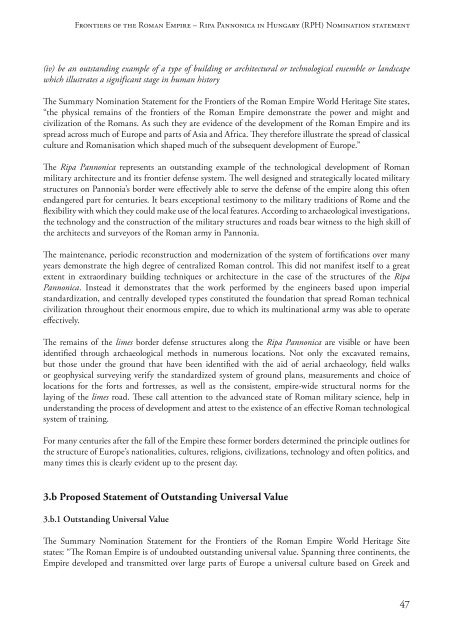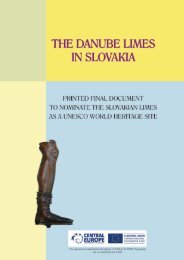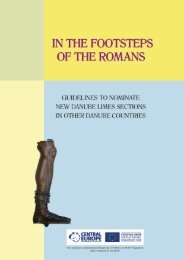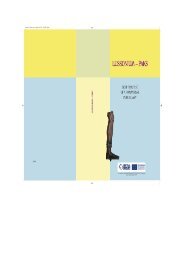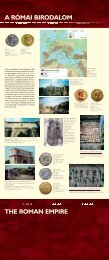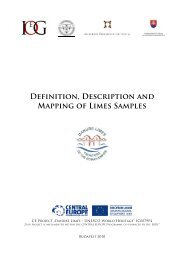the PDF version! - Danube Limes
the PDF version! - Danube Limes
the PDF version! - Danube Limes
Create successful ePaper yourself
Turn your PDF publications into a flip-book with our unique Google optimized e-Paper software.
Frontiers of <strong>the</strong> Roman Empire – Ripa Pannonica in Hungary (RPH) Nomination statement<br />
(iv) be an outstanding example of a type of building or architectural or technological ensemble or landscape<br />
which illustrates a significant stage in human history<br />
The Summary Nomination Statement for <strong>the</strong> Frontiers of <strong>the</strong> Roman Empire World Heritage Site states,<br />
“<strong>the</strong> physical remains of <strong>the</strong> frontiers of <strong>the</strong> Roman Empire demonstrate <strong>the</strong> power and might and<br />
civilization of <strong>the</strong> Romans. As such <strong>the</strong>y are evidence of <strong>the</strong> development of <strong>the</strong> Roman Empire and its<br />
spread across much of Europe and parts of Asia and Africa. They <strong>the</strong>refore illustrate <strong>the</strong> spread of classical<br />
culture and Romanisation which shaped much of <strong>the</strong> subsequent development of Europe.”<br />
The Ripa Pannonica represents an outstanding example of <strong>the</strong> technological development of Roman<br />
military architecture and its frontier defense system. The well designed and strategically located military<br />
structures on Pannonia’s border were effectively able to serve <strong>the</strong> defense of <strong>the</strong> empire along this often<br />
endangered part for centuries. It bears exceptional testimony to <strong>the</strong> military traditions of Rome and <strong>the</strong><br />
flexibility with which <strong>the</strong>y could make use of <strong>the</strong> local features. According to archaeological investigations,<br />
<strong>the</strong> technology and <strong>the</strong> construction of <strong>the</strong> military structures and roads bear witness to <strong>the</strong> high skill of<br />
<strong>the</strong> architects and surveyors of <strong>the</strong> Roman army in Pannonia.<br />
The maintenance, periodic reconstruction and modernization of <strong>the</strong> system of fortifications over many<br />
years demonstrate <strong>the</strong> high degree of centralized Roman control. This did not manifest itself to a great<br />
extent in extraordinary building techniques or architecture in <strong>the</strong> case of <strong>the</strong> structures of <strong>the</strong> Ripa<br />
Pannonica. Instead it demonstrates that <strong>the</strong> work performed by <strong>the</strong> engineers based upon imperial<br />
standardization, and centrally developed types constituted <strong>the</strong> foundation that spread Roman technical<br />
civilization throughout <strong>the</strong>ir enormous empire, due to which its multinational army was able to operate<br />
effectively.<br />
The remains of <strong>the</strong> limes border defense structures along <strong>the</strong> Ripa Pannonica are visible or have been<br />
identified through archaeological methods in numerous locations. Not only <strong>the</strong> excavated remains,<br />
but those under <strong>the</strong> ground that have been identified with <strong>the</strong> aid of aerial archaeology, field walks<br />
or geophysical surveying verify <strong>the</strong> standardized system of ground plans, measurements and choice of<br />
locations for <strong>the</strong> forts and fortresses, as well as <strong>the</strong> consistent, empire-wide structural norms for <strong>the</strong><br />
laying of <strong>the</strong> limes road. These call attention to <strong>the</strong> advanced state of Roman military science, help in<br />
understanding <strong>the</strong> process of development and attest to <strong>the</strong> existence of an effective Roman technological<br />
system of training.<br />
For many centuries after <strong>the</strong> fall of <strong>the</strong> Empire <strong>the</strong>se former borders determined <strong>the</strong> principle outlines for<br />
<strong>the</strong> structure of Europe’s nationalities, cultures, religions, civilizations, technology and often politics, and<br />
many times this is clearly evident up to <strong>the</strong> present day.<br />
3.b Proposed Statement of Outstanding Universal Value<br />
3.b.1 Outstanding Universal Value<br />
The Summary Nomination Statement for <strong>the</strong> Frontiers of <strong>the</strong> Roman Empire World Heritage Site<br />
states: “The Roman Empire is of undoubted outstanding universal value. Spanning three continents, <strong>the</strong><br />
Empire developed and transmitted over large parts of Europe a universal culture based on Greek and<br />
47


